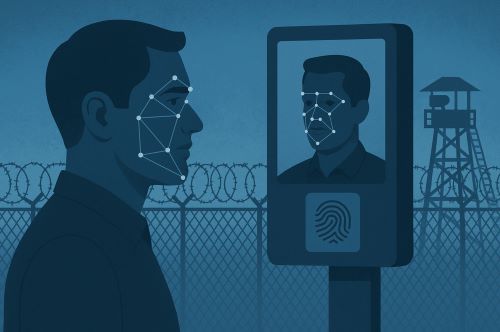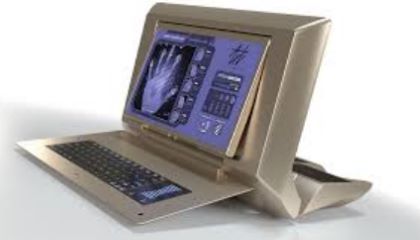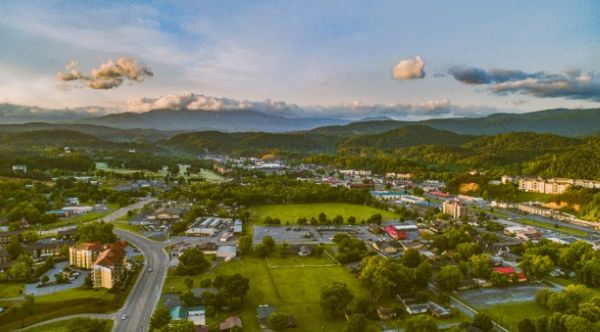

The biometric border is not just a frontier between nations. It is a mirror, reflecting the values a society chooses to elevate or erase.

By Matthew A. McIntosh
Public Historian
Brewminate
The Rise of the Digital Gatekeeper
It begins with a camera. Perhaps mounted above a gate in an international airport, or tucked subtly into the frame of a border patrol checkpoint. It scans faces, logs movements, calculates probabilities. The person passing through might never know what their expression suggested, what biometric markers triggered suspicion, or how their data was fed into an algorithm that now determines the outcome of their journey.
This is not the future. It is the present reality of international migration management, increasingly governed by technologies once reserved for high-security espionage or science fiction. Facial recognition, iris scans, gait analysis, and predictive artificial intelligence systems are becoming central pillars of state border infrastructures. Their proliferation is not just a technological shift but a redefinition of sovereignty, identity, and human rights.
The biometric border is no longer just a fence or a wall. It is a networked system of visibility and suspicion, operating in the space between movement and control.
From Fingerprints to Algorithms: The New Toolkit
What began decades ago with fingerprinting has evolved into a highly sophisticated regime of biometric authentication. Governments worldwide are now integrating facial recognition systems into passport control, visa processing, and asylum screening. The European Union’s Entry/Exit System (EES), for instance, mandates fingerprint and facial data collection for all non-EU travelers. Similarly, the U.S. Customs and Border Protection (CBP) agency deploys facial recognition at over 200 airports and land crossings, quietly transforming how entry is granted or denied.
These systems promise efficiency, but that is a reductive frame. What they truly offer is control: the ability to track, catalogue, and anticipate human movement on a scale previously unimaginable.
Even more insidious is the rise of predictive analytics. Artificial intelligence is now used to assess the likelihood that a person might overstay a visa or commit a crime. In some cases, AI systems recommend whether someone should be flagged for further questioning or detention based on variables as opaque as travel history, facial microexpressions, or social media activity.
These predictive models often operate within black-box frameworks, unaccountable and largely unchallengeable. Decisions that shape a migrant’s future, sometimes life or death, are outsourced to statistical inference.
Surveillance Without Consent

While governments insist these tools are meant for safety and efficiency, the lack of informed consent and transparency cannot be overstated. Refugees, asylum seekers, and other vulnerable migrants are routinely required to submit to biometric processing without clear understanding of how their data will be used or stored.
In Kenya, for example, the UN’s biometric registration of Somali refugees through the BIMS (Biometric Identity Management System) raised significant privacy concerns. Biometric data shared with third-party governments risked exposing individuals to surveillance or political targeting. Meanwhile, in the United States, undocumented migrants apprehended at the border have their faces scanned and stored indefinitely, with minimal oversight or recourse.
Even those passing through “legal” pathways are not immune. Biometric surveillance often extends to visa applicants, family reunification cases, and those seeking temporary work or study abroad. What was once a bureaucratic process of paper and interview has become a technological inquisition.
This disparity in consent and coercion reflects an uncomfortable truth: biometric borders do not treat all bodies equally.
The Tech Arms Race and Its Silent Partners
A global marketplace now fuels the biometric boom. Private companies like Palantir, Idemia, NEC, and Clearview AI provide the software and hardware behind government programs. These firms operate with limited regulation and significant lobbying power. In some cases, their tools are developed and tested in conflict zones or within counterterrorism initiatives before being repurposed for civilian migration management.
Exporting biometric surveillance to the Global South is now common. The EU’s externalization of border control, where biometric tools are deployed in North Africa or the Middle East to stop migrants before they even reach Europe, has turned partner countries into outsourced enforcers of European migration policy. This externalized model has little regard for the domestic political context of these regions or the security risks to individuals being profiled.
These relationships reveal an unsettling reality: surveillance capitalism and migration policy are deeply intertwined. Borders are no longer just militarized. They are monetized.
Human Consequences: Identity, Error, and Exclusion

The biometric border does not merely identify. It defines. And in doing so, it often misreads. Facial recognition systems have repeatedly shown racial and gender bias, with significantly higher error rates for nonwhite individuals. A 2019 NIST study revealed that Asian and Black faces were up to 100 times more likely to be misidentified compared to white faces across many commercial algorithms.
In border scenarios, such errors can mean denial of entry, detainment, or wrongful deportation. For stateless persons or refugees fleeing warzones, the consequences of a mistaken identity can be devastating.
Equally troubling is the presumption that identity is static and readable. In reality, human identity is fluid. Trauma, illness, or age can alter one’s physical appearance. The person crossing a border may not resemble their ID photo for reasons far more human than sinister. Yet the system demands consistency, and any deviation risks being treated as deception.
This mechanistic logic erodes the space for empathy, discretion, and context. It substitutes judgment with computation.
Resistance, Rights, and the Possibility of Reimagining
Despite its scale, the biometric border is not unchallenged. Civil liberties organizations have pushed back on facial recognition deployments, calling for moratoriums or outright bans. In 2020, the city of San Francisco banned the use of facial recognition technology by city agencies, citing the risk of civil rights violations. The European Parliament has debated the limits of predictive policing and algorithmic bias, albeit with slow regulatory action.
Legal scholars and activists argue that biometric data should be treated with the same protections as other sensitive personal information, if not more. After all, you can change your password, but not your face.
What might a more humane and rights-respecting border look like? That remains unclear. But it would likely require placing the human story back at the center of migration policy, not as a token gesture of empathy but as a structural principle. It would mean rejecting the seductive ease of automation in favor of processes that recognize dignity, fallibility, and context.
Technology itself is not the enemy. Its use without accountability, consent, or justice is.
Conclusion: A Mirror and a Warning
The biometric border is not just a frontier between nations. It is a mirror, reflecting the values a society chooses to elevate or erase. It tells us who we trust, who we fear, and who we believe deserves to move freely.
As governments rush to secure their borders through predictive tools and automated suspicion, they risk undermining the very freedoms they claim to protect. Surveillance can never substitute for policy grounded in equity and humanity. In the end, the race to control borders through technology may reveal less about migrants and more about ourselves. The question is not simply who crosses, but what we are building when we decide how they may be seen.
Originally published by Brewminate, 07.17.2025, under the terms of a Creative Commons Attribution-NonCommercial-NoDerivatives 4.0 International license.


